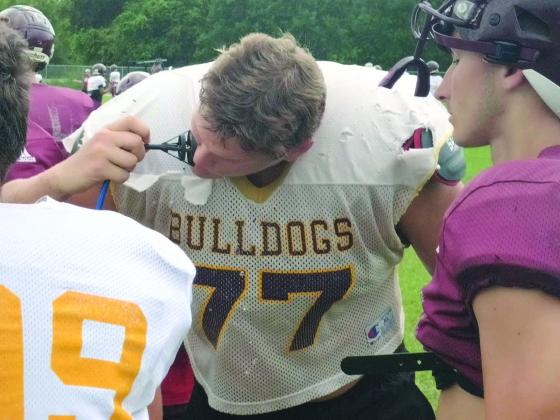It’s been hot this summer. Like, it’s been really hot this summer.
You don’t need a weather report on your sports page — especially after opening your most recent electric bill – but what may be surprising is to learn that the blistering temperatures are also having a direct effect on our high school athletes and coaches as they try to prepare for the upcoming outdoor fall seasons.
The sport most affected by the dangerous heat and humidity is football.
In order to keep student athletes safe, all county coaches and athletic directors having been using the wet bulb globe temperature readings, a system that has been utilized for the last couple of years.
A wet-bulb reading is the temperature read by a special thermometer that is wrapped in water-soaked fabric and ventilated. This thermometer is part of a device called a psychrometer. It includes a dry-bulb thermometer, a wet-bulb thermometer and a psychrometric chart - a graph that plots the relationships between the dry and wet-bulb temperature, relative humidity, and dew point at constant pressure.
By definition, wet-bulb temperature is the lowest temperature a portion of air can acquire by evaporative cooling only. When air is at its maximum (100 %) humidity, the wet-bulb temperature is equal to the normal air temperature (dry-bulb temperature). As the humidity decreases, the wet-bulb temperature becomes lower than the normal air temperature. Scientific studies have determined that when the temperature reaches 95 degrees with a relative humidity of 100% for an extended period of time, the human body simply cannot cool itself and serious injury or death could result. Because of this, guidelines have been put in place to protect anyone spending significant time outdoors – including athletes.
Using this data, the FHSAA has come up with guidelines that all public and private school members must follow to keep athletes safe. When the wet bulb globe temperature (WBGT) is 82 degrees or less, there are no restrictions on outdoor practices. From 82.6 to 86.9, coaches are asked to use discretion and must provide at least three rest and hydration breaks per hour.
When the WBGT reaches 87.1 to 90 degrees, practice is limited to two hours in helmets, shorts and shoulder pads only. From 90.1 to 91.9, outdoor practices are limited to one hour with no shoulder pads or helmets worn. No conditioning drills can be held and extended hydrationrest breaks are required. A wet bulb temperature of 92 essentially prohibits teams from practicing outdoors.
A recent example was provided last week by Osceola football Coach Eric Pinellas. The outdoor temperature read 91 degrees, and the feel like temperature – which is not used in the calculation – was hovering around 100 degrees. But with the lower humidity, the wet bulb temperature was 84 degrees, which allowed the Kowboys to participate in a full outdoor practice with rest and hydration protocols in place.
Those regulations are not limited to football and apply to all outdoor sports including cross country, golf and even swimming.
St. Cloud athletics director Bryan Smart noted that on more than one occasion since the beginning of camp the wet bulb reading has forced the Bulldogs to either limit practices or move them indoors.
“This has been a brutally hot since camp opened and this time of year also brings dangerous lightning situations.” Smart said. “Obviously the athletes and coaches want to be prepared for their seasons, but safety has to be and will always be our top priority.”
“When you are forced inside to the gym, you simply cannot get all the work in you need to,” Pinellas noted. “But the bottom line is the safety and health of our student athletes are the most important thing. There are other things we can try to do, but the choices are not always ideal.”
Those alternatives include practicing early in the morning — Harmony has been taking in a 5 a.m. practice session prior to the season — or later in the evening. But with school starting, all practices by a different FHSAA rule, must conclude by 9 p.m. on school nights. Early morning practices on school days may work for small squads like cross country, but is far from ideal for large team sports like football – where getting to practice would present transportation problems for parents.
Although football, with its strenuous nature and equipment, is the obvious sport affected by the heat and humidity – it does apply to all sports.
“The WBGT regulations are in place for all outdoor sports as well as physical education classes,” Osceola County Athletics Director Ryan Adams noted. “All coaches and athletic directors have this app on their phones and consult it daily. It’s been hotter than normal this August and I know this has created some issues for our coaches but safety is the most important thing.”



